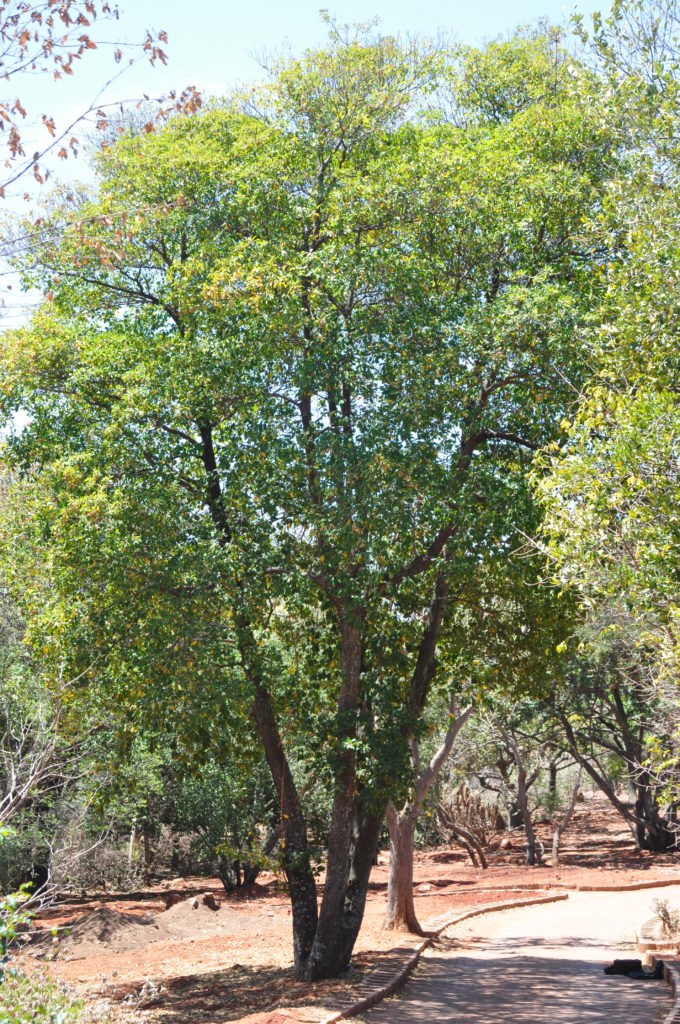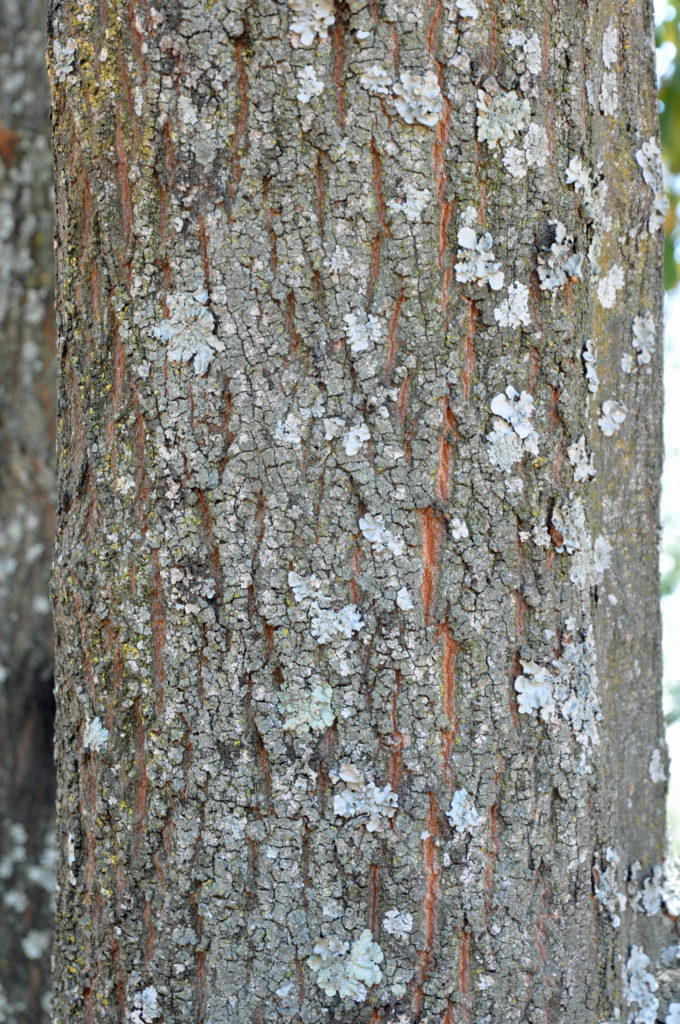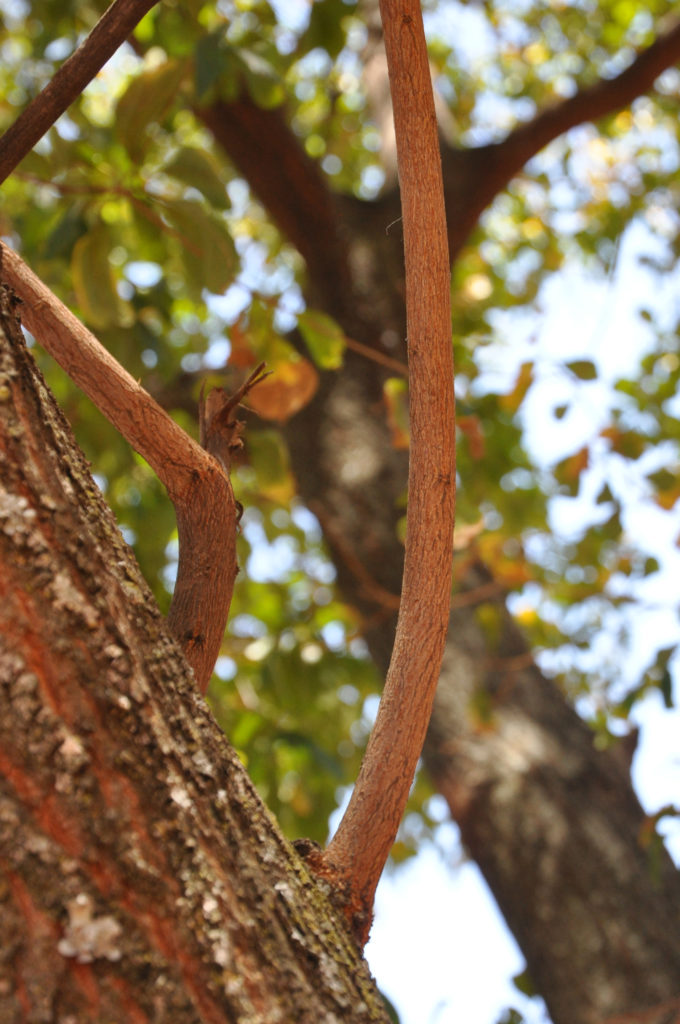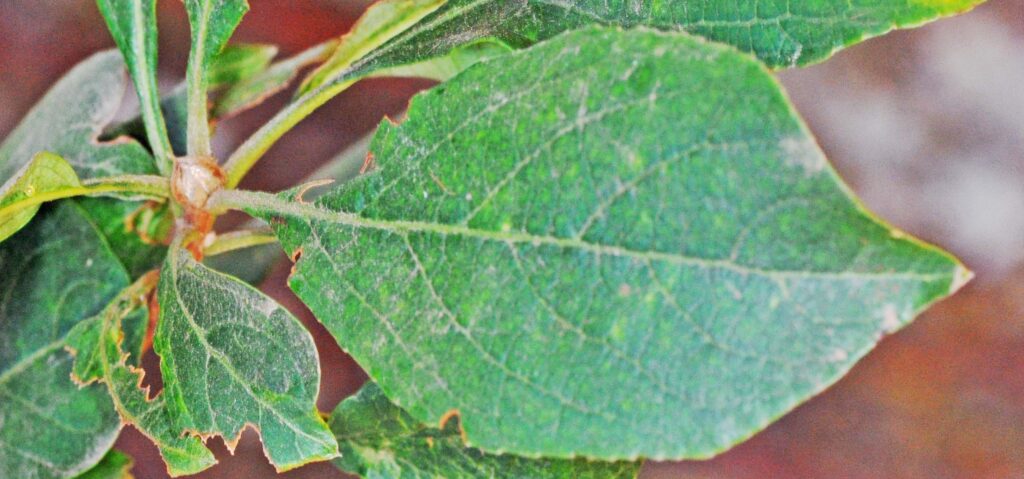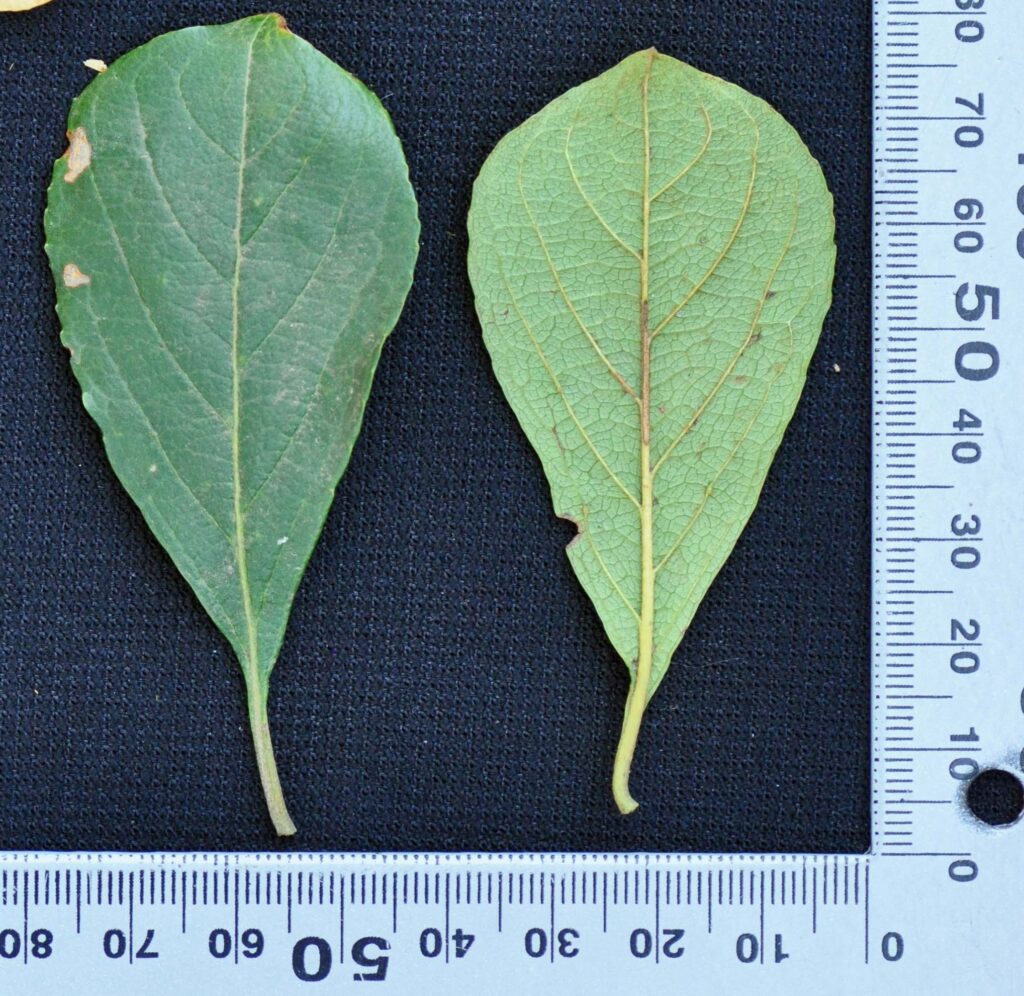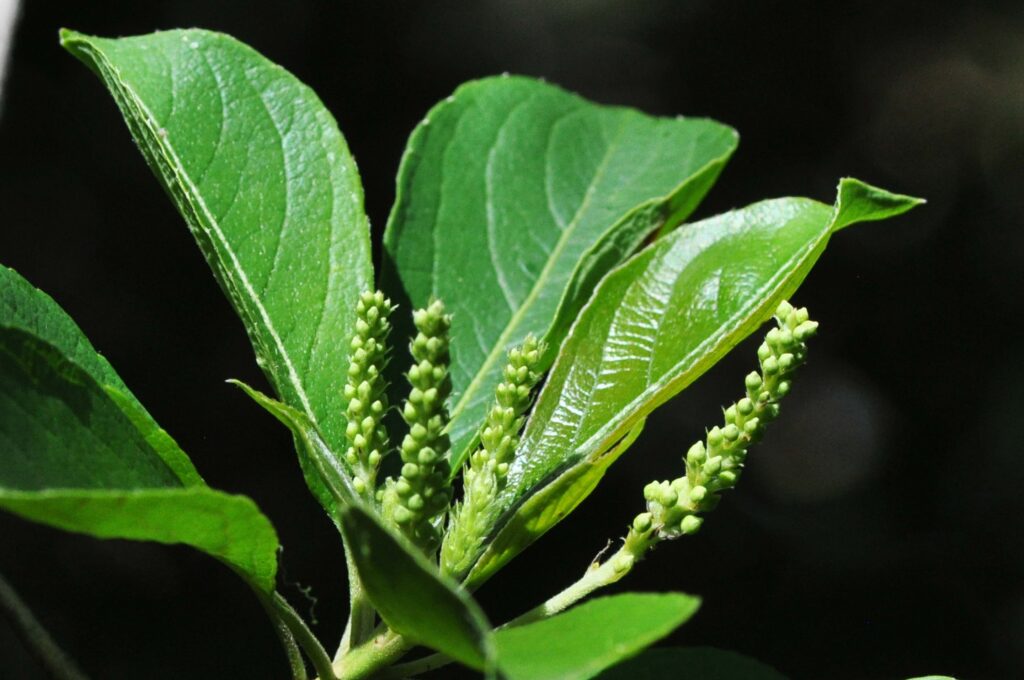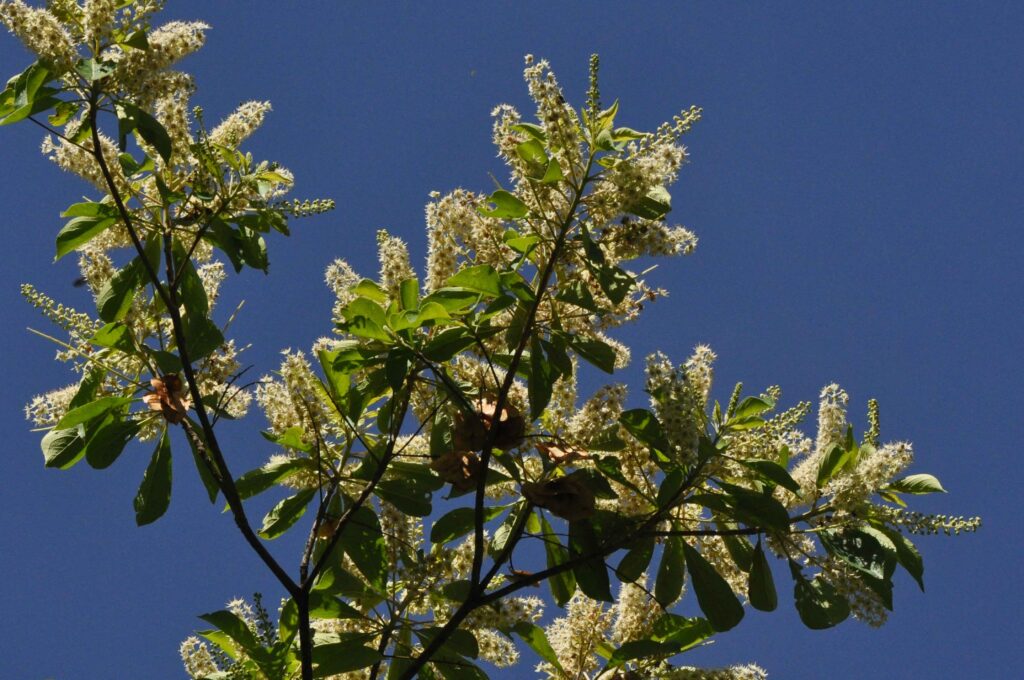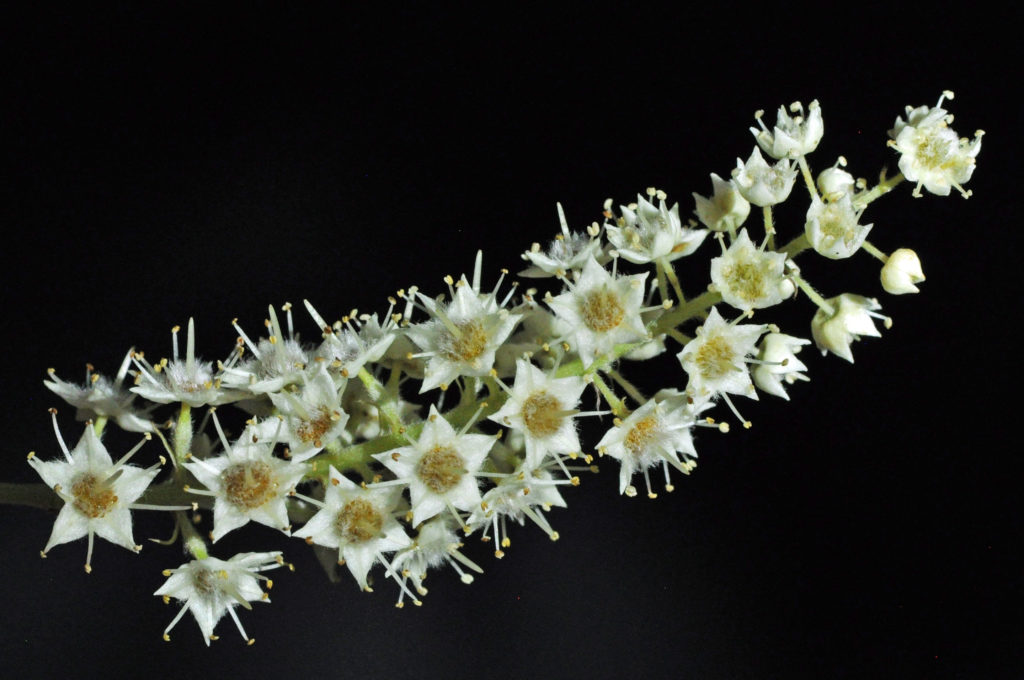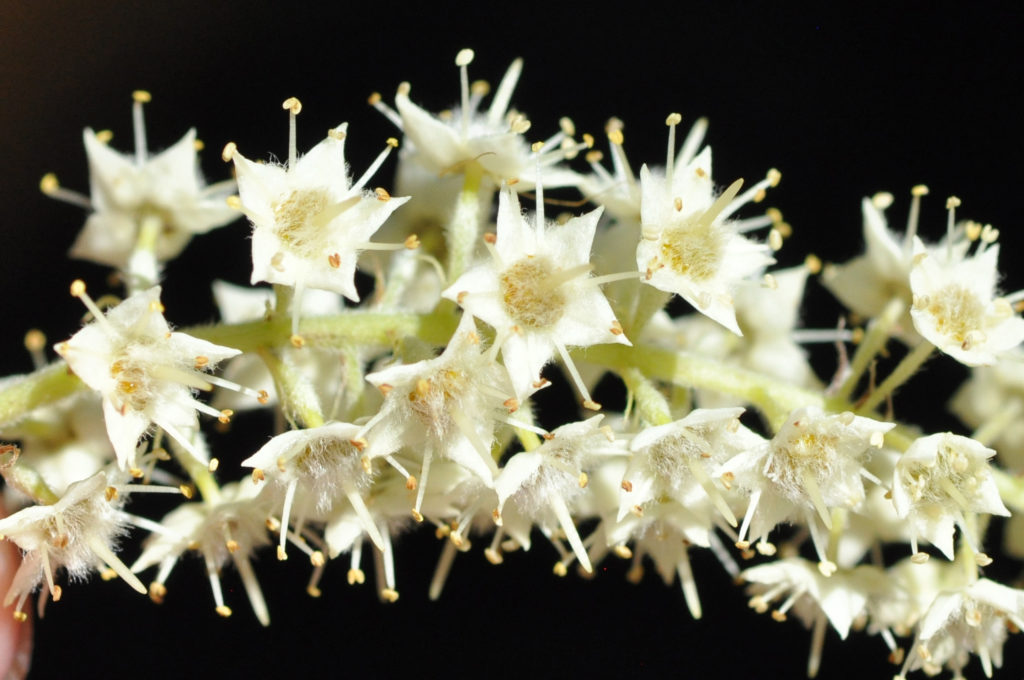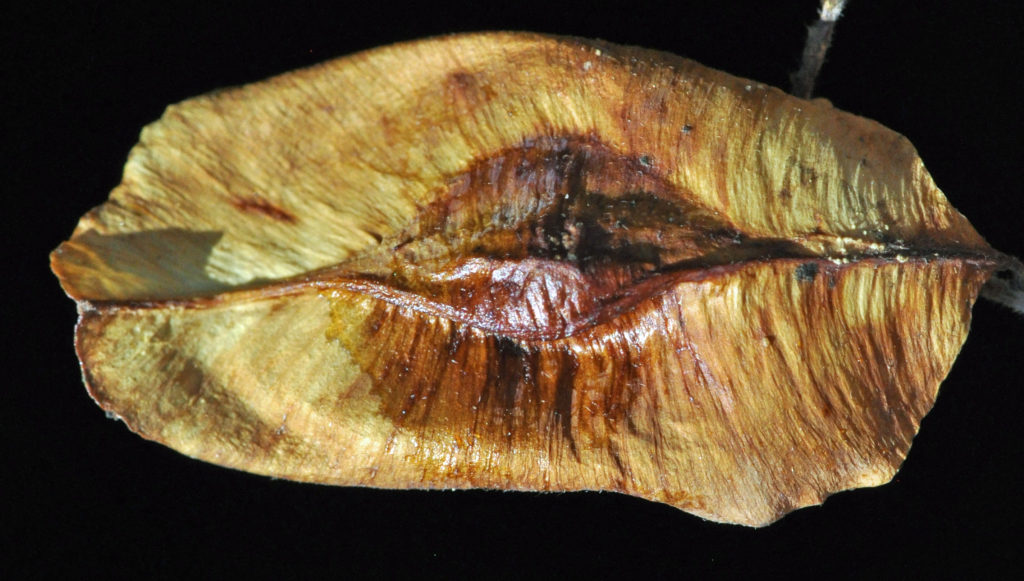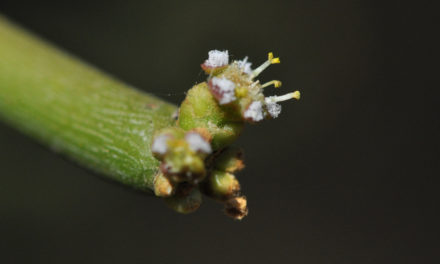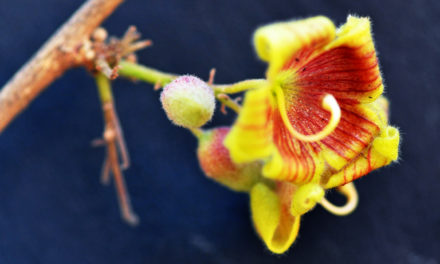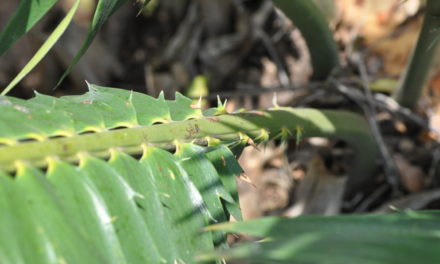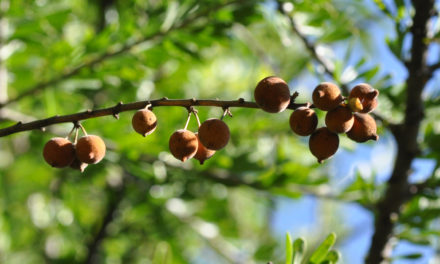General Info – summary
This attractive multi-stemmed shrub or Tree is up to 6m+ high. The brown/black bark has a red underbark. Obovate, simple Leaves are up to 10 x 5cm. Whitish, regular, small Flowers lack petals & are in impressive spikes – male near the apes and bisexual below. Ten exserted stamens are present. The one locular ovary is inferior and can be confused with an absent pedicel. Fruit: a 1-seeded, winged samara.
Description
Terminalia phanerophlebia
SA Tree No. 549.
Common names: (Afr) Bastergeelhout, Lebombotrosblaar. (Eng) Lebombo Cluster-leaf. (isiZulu) Amangwamhlophe, Amangwansundu, Amangwe, Amangwe-ampofu, Amangwe-amnyama, Amangwe-omphofu. (siSwati) mambonjwane, Umangwe, Umhonono.
Family: Combretaceae (Bushwlillow family). In this family, there are about 16 genera, which contain about 530 species. In South Africa, there are 5 genera and 41 species. Here the genera with Trees include Combretum, Lumnitzera, Pteleopsis and Terminalia. The simple and usually entire Leaves lack stipules. Flowers are usually bisexual. There are usually twice the number of stamens as sepals or petals. The inferior Ovary has 1 locule and usually only 1 of the ovules develops into a seed. Fruit is usually indehiscent and may be winged or ridged.
Name derivation: Terminalia – crowded towards the ends of branches – referring to the leaves. phanerophlebia – distinctly veined – referring to the lower side of the leaves.
Conservation: National Status: L C. (Least Concern). Assessment: 2005 (W. Foden and L. Potter).
Tree
This multi-stemmed shrub or small Tree may reach 6m+ high and is cone shaped or flat-topped (photo 747). The fissured Bark on the trunk is dark grey to black and between the ridges, the reddish underbark may be visible (photo 749). The Trunk is up to 30cm in diameter and may be straight or crooked. The reddish to purplish bark on the pointed branchlets is shiny (photo 750) and peels off in small rings. The branches do not break easily. They tend to be high up in horizontal layers. Scales, spines and microscopic stalked glands are absent.
- 747 2016.10.11 Pretoria NBG. Photo: David Becking.
- 749 2016.10.11 Pretoria NBG. Photo: David Becking.
- 750 2016.10.11 Pretoria NBG. Photo: David Becking.
Leaves
This Tree may be evergreen or semi deciduous. The leathery, down curved Leaves may be broadly obovate (the reverse of ovate, the terminal half is broader than the basal – photo 742) and tend to be concentrated towards the ends of branches. They may to be scattered or spirally arranged. On new growth, they occur singly or are opposite. Individual leaves are up to 10 x 4,5cm and are simple (has a single blade which may have incisions that are not deep enough to divide the blade into leaflets). Young leaves initially have some silvery hairs on both sides. Most of these are lost at maturity. Autumn leaves are pink to yellow. The wavy Margin is entire (with a continuous margin, not in any way indented) or slightly scalloped towards the apex. The Apex may be pointed (photo 641), round or notched and may end with an abrupt down facing point (photo 742). The Base narrows and the leaf is a lighter green below (photo 742). Four to seven pairs of conspicuous raised Veins are more visible and protrude on the lower surface and are distinctly sunken above (photo 742). The Petiole (leaf stalk) is up to 2 cm long and may be grooved on the upper side (photo 742). N.B. the petiole is not included on the length of the leaf.
- 641 2016.08.23 Pretoria NBG. Photo: David Becking.
- 742 2016.08.23 Pretoria NBG. Photo: David Becking.
Flowers
The small (up to 4mm wide) white to cream/pale yellow and strongly unpleasantly scented Flowers are borne on 10cm long slender and axillary Spikes (simple indeterminate inflorescence with sessile flowers on a single unbranched stalk. Spikes develop in leaf axils (photos 605 & 610) and are up to 10cm long. The Disc (a more or less fleshy or elevated development of the receptacle – the expanded tip of the flower stalk from which the floral parts develop. It is greatly expanded in the Asteraceae and Ficus). The receptacle is hairy and ends with the sepals. Here the receptacle expands into a shallow cup, ending in a hairy Calyx with 5 lobed Sepals (photo 612). Petals are absent and the cream to pale yellow sepals provide flower colour.
The flowers near the apex of the spike are male (photo 612) and those near the base are bisexual – both in the same inflorescence. The Male flowers (photo 612) have stalks, which only resemble pedicels but correspond to the lower receptacle with abortion of the ovary. The 10 Stamens protrude beyond the sepals and each of their filaments is dorsifixed (attached by or at the back) to a free-moving Anther (photo 612). Each anther opens forming a V-shape (photo 615). In the sessile Bisexual flower (photo 615), there is a single Pistil (a unit of the Gynoecium, the Female element of the flower, composed of the Ovary, Style and Stigma) and the one locular Ovary is inferior. The single Style is free, and the Stigma is not expanded (photo 612). (Oct-Feb).
- 605 2016.11.22 Pretoria NBG. Photo: David Becking.
- 610 2016.11.22 Pretoria NBG. Photo: David Becking.
- 612 2016.11.22 Pretoria NBG. Photo: David Becking.
- 615 2016.11.22 Pretoria NBG. Photo: David Becking.
Fruit
The indehiscent Fruit is a Samara (an attractive dry, indehiscent winged fruit. The wing is papery and develops from the ovary wall). This surrounding flat hard wing has a raised central part containing the single Seed (photo 170). The minutely hairy fruit is greenish yellow to pink, with short hairs and is up to 4 x 3 cm. It may turn reddish brown when mature. (Jan-Sep+).
- 170 2018.03.14 Pretoria NBG. Photo: David Becking.
Distribution & Ecology
This low altitude tree is Endemic (restricted to a particular geographic location) in southern Africa and is found in KwaZulu-Natal, Mpumalanga, Swaziland and southern Mozambique. It grows on stony hillsides, bushveld and in valleys – close to streams. Elephant browse the Leaves.
Ethnobotany
The Wood is relatively dense, hard and has a coarse grain. Seeds from cultivated trees tend to grow best. Crude extracts from Terminalia phanerophlebia have shown good antimicrobial and anti-inflammatory activities. Roots and Bark are used in traditional medicine. This plant is suitable for planting as a street tree and can develop into a worthwhile shade tree for the home.
References
Boon, R. 2010. Pooley’s Trees of eastern South Africa. Flora and Fauna Publications Trust, Durban.
Burrows, J.E., Burrows, S.M., Lotter, M.C. & Schmidt, E. 2018. Trees and Shrubs Mozambique. Publishing Print Matters (Pty) Ltd. Noordhoek, Cape Town.
Coates Palgrave, M. 2002. Keith Coates Palgrave Trees of Southern Africa, edn 3. Struik, Cape Town.
Foden, W. & Potter, L. 2005. Terminalia phanerophlebia Engl. & Diels. National Assessment: Red List of South African Plants version 2020.1. Accessed on 2024/02/11.
Lawrence, G. H. M, 1951. Taxonomy of Vascular Plants. The Macmillan Company, New York. Tenth Printing 1965.
Palmer, E. & Pitman, N. 1972. Trees of southern Africa. Balkema, Amsterdam, Cape Town.
Schmidt, S. Lotter, M. & McCleland, W. 2002. Trees and Shrubs of Mpumalanga and the Kruger National Park. Jacana, Johannesburg.
van Wyk, B. & van Wyk, P. 1997 Field guide to Trees of Southern Africa. Struik, Cape Town.
http://www.plantzafrica.com/planttuv/terminaliaphanero.htm
https://www.ncbi.nlm.nih.gov/pubmed/25218320
http://wiredspace.wits.ac.za/bitstream/handle/10539/7604/GSibandze_MScNov2009_s.pdf?sequence=1
http://agris.fao.org/openagris/search.do?recordID=US201400005918
http://posa.sanbi.org/flora/browse.php?src=SP

